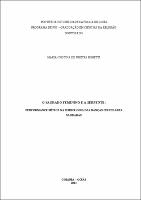| Compartilhamento |


|
Use este identificador para citar ou linkar para este item:
http://tede2.pucgoias.edu.br:8080/handle/tede/3618| Tipo do documento: | Tese |
| Título: | O SAGRADO FEMININO E A SERPENTE: PERFORMANCE MÍTICA NA SIMBOLOGIA DAS DANÇAS CIRCULARES SAGRADAS |
| Autor: | Bonetti, Maria Cristina de Freitas  |
| Primeiro orientador: | Silva, José Carlos Avelino da |
| Primeiro membro da banca: | Reimer, Haroldo |
| Segundo membro da banca: | Garcia, Gilberto Gonçalves |
| Terceiro membro da banca: | Baptista, Tadeu João Ribeiro |
| Resumo: | Esta tese investiga as sobrevivências e a camuflagem do Mito da Serpente e do culto à Grande Mãe nas performances mítica e ritualística das Danças Circulares Sagradas na contemporaneidade. Para isso, refaz a trajetória do mito desde a antiguidade, explorando o imaginário da criação e suas diversas expressões em culturas arcaicas no mundo ocidental. O principal objetivo da pesquisa é demonstrar a sobrevivência da simbologia da Deusa Mãe e do Mito da Serpente nas diferentes expressões culturais em diálogo com as Danças Circulares Sagradas. Busca, ainda, identificar a mensagem oculta que se externaliza mediante os movimentos corporais que geram expressões arquetípicas codificadas nas danças e performances ritualísticas; e explora, do mesmo modo, os domínios da Grande Mãe e da Serpente, sua polissemia simbólica e a maneira como se organizam em termos artísticos e espaciais. A principal questão da tese é se a simbologia da serpente pode ser considerada como temática mítica sobrevivente na Dança Circular Sagrada na contemporaneidade. Tendo como inspiração metodológica a concepção hermenêutica de análise, nesta tese busca-se conectar o Mito da Serpente às obras mais relevantes no que tange ao Sagrado Feminino, à história, à antropologia e às performances ritualísticas. A literatura será revista em seus eixos temáticos e, em especial, nos autores e estudiosos reconhecidos nas Ciências da Religião. Em meio às interpretações conceituais, a pesquisa realiza levantamentos das produções recentes sobre a temática de estudo para discutir as acepções e os desdobramentos inspirados em tradições ancestrais e com intenso poder de reatualização mítica; e, nesta discussão, aborda-se o aspecto das danças que revivem o simbolismo da serpente e ressignificam ritualisticamente os mitos arcaicos. As Danças Tradicionais e Folclóricas, realizadas como performances artísticas, ou mesmo espontaneamente, sobrevêm ao espaço criado pelas festas tradicionais, reatualizam e vivificam mitos e rituais pré-históricos na contemporaneidade. Considera-se, portanto, que a simbologia da Serpente é uma temática mítica da Deusa Mãe que sobreviveu nos atos performatizados e ritualísticos das Danças Circulares Sagradas contemporâneas. |
| Abstract: | This thesis investigates the survival and the camouflage of the Myth of the Serpent and the Cult to the Great Mother in mythic and ritualistic performances of the Sacred Circle Dances nowadays. For this, it remakes the myth trajectory since ancient times, exploring the imagery of creation and its various expressions in archaic cultures in the Western World. The main objective of the research is to demonstrate the survival the symbolism of the Mother Goddess and the Serpent Myth in different cultural expressions in dialogue with the Sacred Circle Dances. It also takes into to identify the hidden message that externalizes through body movements that generate archetypical expressions codified in the ritualistic dances and performances, and explores in the same way, the domains of the Great Mother and the Serpent; its symbolic polysemy and the way they are organized in artistic and spacial terms. The main issue of this thesis is that whether the symbolism of the serpent can be considered as a mythical theme survival in the contemporary Sacred Circle Dance. Taking as methodological inspiration the hermeneutic conception of analysis, in this thesis the purpose is to connect the Myth of the Serpent with the most relevant works regarding the Sacred Feminine, history, anthropology and the ritualistic performances. The literature will be reviewed in its thematic axles and in particular the authors and the known experts in the Sciences of Religion. Amid the conceptual interpretations this research produces surveys of recent works on the subject of study to discuss the meanings and the ramifications inspired by ancient traditions and with deep power refresher mythical; and in this discussion, focuses on the aspect of the dances that revive the serpent symbolism and ritually reframe the archaic myths. Traditional and Folk Dances, realized as artistic performances, or even spontaneously, come upon the space created by the traditional parties, replace and vivify myths and prehistoric rituals nowadays. It is considered, therefore, that the Serpent symbology is a mythical theme of the Mother Goddess who survived the performed and ritualistic acts in the contemporary Sacred Circle Dances. |
| Palavras-chave: | Sagrado Feminino; Mito da Serpente; Danças Circulares Sagradas; Performances Artísticas. Sacred Feminine; The Serpent Myth; Sacred Circle Dances; Artistic Performances. |
| Área(s) do CNPq: | CIENCIAS HUMANAS::TEOLOGIA |
| Idioma: | por |
| País: | Brasil |
| Instituição: | Pontifícia Universidade Católica de Goiás |
| Sigla da instituição: | PUC Goiás |
| Departamento: | Escola de Formação de Professores e Humanidade::Curso de Teologia |
| Programa: | Programa de Pós-Graduação STRICTO SENSU em Ciências da Religião |
| Citação: | Bonetti, Maria Cristina de Freitas. O SAGRADO FEMININO E A SERPENTE: PERFORMANCE MÍTICA NA SIMBOLOGIA DAS DANÇAS CIRCULARES SAGRADAS. 2013. 381 f. Dissertação (Programa de Pós-Graduação STRICTO SENSU em Ciências da Religião) - Pontifícia Universidade Católica de Goiás, Goiânia - GO. |
| Tipo de acesso: | Acesso Aberto |
| URI: | http://tede2.pucgoias.edu.br:8080/handle/tede/3618 |
| Data de defesa: | 14-Ago-2013 |
| Aparece nas coleções: | Doutorado em Ciências da Religião |
Arquivos associados a este item:
| Arquivo | Descrição | Tamanho | Formato | |
|---|---|---|---|---|
| MARIA CRISTINA DE FREITAS BONETTI.pdf | Texto Completo | 53,37 MB | Adobe PDF |  Baixar/Abrir Pré-Visualizar |
Os itens no repositório estão protegidos por copyright, com todos os direitos reservados, salvo quando é indicado o contrário.




